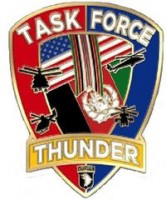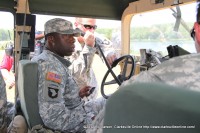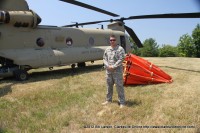 Fort Campbell, KY –
Fort Campbell, KY –  At Lake Kyle on Friday, Members of Company B, 7th Battalion, 101st Aviation Regiment, part of the 159th Combat Aviation Brigade at Fort Campbell conducted Wildland Firefighting Training. Soldiers from the 159th Combat Aviation Brigade are currently part of the reaction force for National Wildland Firefighting. The Soldiers must be prepared to respond to a Presidential directive to support civilian agencies, including the National Interagency Fire Center located in Boise, Idaho, which coordinates the national response to wildfires.
At Lake Kyle on Friday, Members of Company B, 7th Battalion, 101st Aviation Regiment, part of the 159th Combat Aviation Brigade at Fort Campbell conducted Wildland Firefighting Training. Soldiers from the 159th Combat Aviation Brigade are currently part of the reaction force for National Wildland Firefighting. The Soldiers must be prepared to respond to a Presidential directive to support civilian agencies, including the National Interagency Fire Center located in Boise, Idaho, which coordinates the national response to wildfires.
Currently in the United States there are 52 ongoing large wildfires affecting 901,215 acres. This number includes 4 in Alaska, 4 in Arizona, 7 in Colorado, 1 in Hawaii, 3 in Idaho, 8 in Montana, 3 in Nevada, 3 in New Mexico, 1 in North Carolina, 2 South Dakota, 2 in Tennessee, 6 in Utah, 2 in Virginia, and 5 in Wyoming. With the number of fires ongoing aviation assets are being stretched thin.
Department of Defense aircraft are already in the fight, as two Modular Airborne Fire Fighting System (MAFFS) C-130 aircraft’s from the 302nd Airlift Wing from U.S. Air Force reserve, located out of Colorado Springs; and another two from the 153rd Airlift Wing part of the Wyoming air National Guard located out of Cheyenne had been allocated to assist with wildland firefighting. Just a few hours ago, it was reported that one of the C-130s from the 302nd airlift wing has crashed while fighting the White Draw Fire in South Dakota. So as you can see, there is a great need for the soldiers of the 159th Combat Aviation Brigade to be ready to do their part.
While the call has not yet come in from President Barack Obama for the unit to take part in fighting the wildfires currently underway, that could change at a moment’s notice. If that occurs, these highly trained aircrews will be on scene a short time later, doing their part to protect the lives and property of civilians on the ground.

The training involved Air Traffic Control crews who coordinated the actions of the aircraft, as well as the aviation assets. Communications were constantly maintained to ensure the safety of all involved. This was the last stage of the training with saw both aircrews training both day and night, as well as getting extremely realistic practice with US forestry service crews.
The helicopter flew in and dipped the 600 pound “Bambi Bucket” into the water of the lake, picking up 2000 gallons of water that when fighting a wildfire could make the difference between keeping a it under control or losing it. The aircraft then flew off circling the lake before coming back in dumping its load onto a fixed point on the surface. While 2000 gallons may not seem like a lot it’s over 16,500 pounds of water, which easily covers 100 meters of fire line.

Manufactured and marketed by SEI Industries, the Bambi bucket has revolutionized airborne firefighting. The bucket enhances the accuracy of the delivering aircraft and ensures that a solid column of water reaches the fire. The Bambi bucket is a collapsible bladder with a solid steel ring around the front of it , which provides an instant deployment system once the water starts filling the bucket so that it starts filling manual. The only actuation or mechanical component is a small cable that is routed to the inside aircraft that the crew member releases once the aircraft is over a predetermined release point or over the fire itself, and sometimes forestry service can provide the fire spotter on the ground to direct aircraft via the radio.

CW3 Ryan Dechent is one of the company standardization officers for his unit, and he explained the importance of what they were doing, ” The purpose of the training is to expand the capabilities of the United States Army specifically by Company B – 7th Battalion, with a lot of our experienced crews starting to PCS out of the unit, the goal is to get the junior guys such as CW2 Dusty Snivall who are going to be staying with the unit up to speed on the system. So when if called. They can provide fire suppression support in both the local area and anywhere in the contiguous United States, since we are capable of self deployment. We get an aviator reasonably proficient after 1 hour of classroom time, and about 1.5 flight hours. Coordination between aircraft and ground crews is a key to making sure that we get the water on target when, and where they want it.”
“Getting the opportunity to assist in fighting these fires would be fantastic. Speaking for the majority of the guys if not all of the men in my unit alone. We all wish that there was more opportunities for us to support the citizens of the United States, versus instead of just doing things overseas,” said Dechent. “Whether that’s humanitarian, public relations missions, fire support, hurricane relief up missions, any opportunities for us to do that. It’s just a fantastic feeling for us to be able to provide that level of support to American citizens. Any time we get an opportunity to work with local governments or civilian agencies, it’s a great feeling because it is an instant sense of accomplishment and we actually get the chance to help the citizens of the United States!”

SSG Jonathan Pena-Reyes is in charge of training all the crew members of the back of the helicopter, “A very big part of our training is getting the mission done, doing all of the steps that you have to do to accomplish the mission on time and safely. We cover every step that we possibly can. We go through various scenarios, cover the emergency procedures, pretty much anything that we can think of as a crew that can happen to us, and prevent us from doing this mission successfully. That’s what we cover in training scenarios like this so that when the real thing comes everything goes as smoothly as possible.”
He continued, “It is part of our mission in the U.S. Army to help people both here at home and overseas. We pretty much have it all figured out in our minds. We all pay attention to the news, and we’re ready to go. Worse comes to worse this is what we’ve trained for, and we will just take it as another mission whether it’s in Colorado or anywhere else in the world.”


























